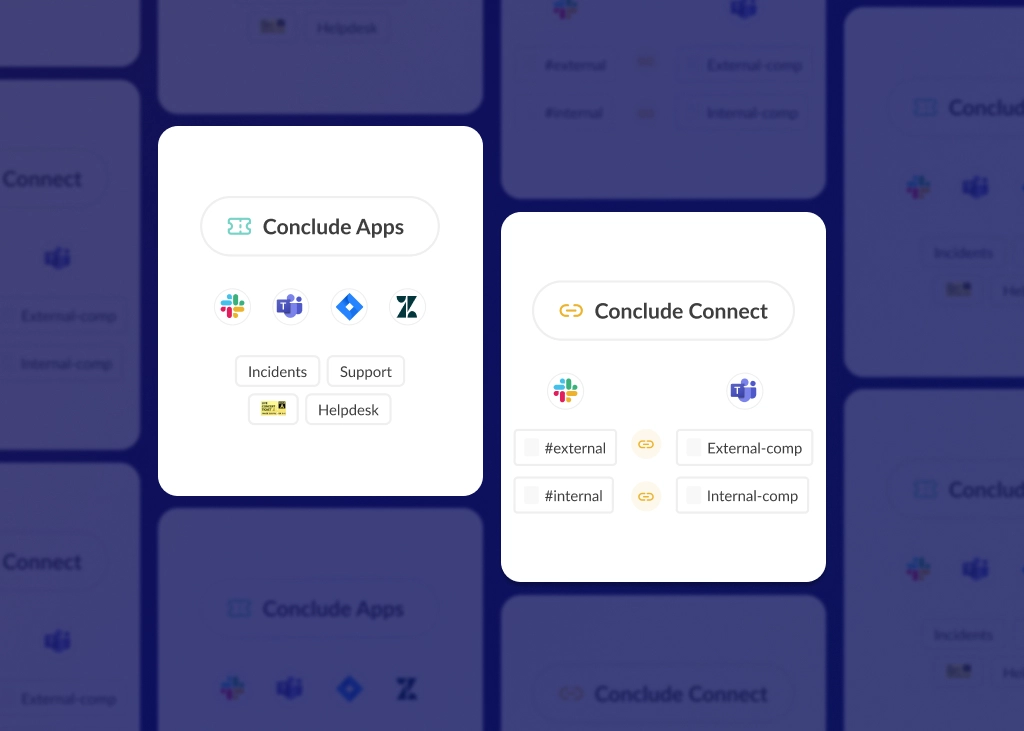Silo Mentality: How to Understand, Recognize and Solve Workplace Silos

Silo mentality – when departments or teams operate in isolation – is one of the biggest threats to collaboration and workplace efficiency. It creates communication gaps, duplicated work, and missed opportunities across an organization.
Despite an abundance of apps and tools, workplace silos still form – but why? Most often, it’s due to a mix of competitive cultures, fragmented tech stacks, and leadership structures that fail to promote cross-team collaboration.
In this article, we’ll break down what silo mentality means, how to recognize it, and practical strategies to reduce or eliminate it for good.
Read: Top Collaboration Tools for Remote or Distributed Teams
What Is Silo Mentality?
Silo mentality is a mindset that occurs when departments or teams within an organization are reluctant to share information, goals, or tools with others. It leads to fragmented communication, duplicated efforts, and a lack of alignment across the business.
But sometimes it can occur because people lack awareness about what other information is available across the organization, and it is often a symptom of poor cross-team collaboration.
Silo mentality often emerges from competitive workplace cultures, disconnected technologies, or leadership structures that don’t prioritize collaboration in the workplace. When left unaddressed, it can slow decision-making, reduce efficiency, and create barriers to innovation.
Why Is It Important to Avoid It?
Workplace silos don’t just impact internal teams, they also affect customer experience, employee morale, and long-term growth.
Salesforce research indicates that siloed information is a significant barrier to customer service:
- 70% of customers expect all representatives to have access to the same information, however;
- 55% feel like they’re dealing with separate departments instead of one unified company
- Disconnected experiences are cited as the number one frustration for customers
ResearchGate also published a case study on the impact of silo mentality on team identity. It showed how deeply ingrained silos can fragment team identity and lead to “extreme emotional confusion and exhaustion” among team members.
Silo mentality creates an environment where departments treat each other as rivals rather than collaborators, affecting the overall team dynamics and organizational cohesion.
These outcomes make it clear: organizations that break down silos perform better – both internally and in the eyes of their customers.
Read: Slack and Teams Interoperability: The Complete Setup Guide
What Causes Silo Mentality?
Silo mentality doesn’t appear out of nowhere – it’s usually the result of structural and cultural issues that prevent open communication and shared objectives across teams.
Here are some of the most common causes:
- Competitive workplace culture – when departments or team leads are incentivized to outperform each other rather than work together, collaboration becomes secondary to internal competition. This mindset often starts at the management level and trickles down
- Lack of unified communication – without a shared communication platform, teams default to email, DMs, or tool-specific chats that exclude others. This results in fragmented conversations and lost context. It can also lead to shadow messaging
- Technological barriers – using different tools across departments – e.g. a CRM in sales, issue tracking tools in the dev team, other knowledge bases in support – all create gaps. Teams may struggle to access each other’s work or align on processes
- Inflexible organizational structures – traditional hierarchies and department silos often restrict information flow. If leadership doesn’t actively promote cross-functional collaboration, teams remain isolated by default
Recognizing these root causes is the first step to addressing silo mentality and building a more connected, collaborative workplace.
Signs of a Siloed Team
Siloed teams aren’t always obvious, especially in fast-moving organizations or companies with distributed teams. But some patterns signal when communication and collaboration may be breaking down.
Here are some common signs of a siloed business:
- Teams using different tools for the same purpose – leading to duplication, inefficiencies, and integration issues
- Information is shared privately – via DMs or email instead of in dedicated channels where others can stay informed
- Goals and KPIs are tracked in isolation – with each team focused only on their own success, rather than shared company-wide outcomes.
- Employees don’t know what other departments are working on – making alignment and coordination more difficult
- Customers may need to repeat themselves – across sales, support, and success teams, due to poor internal handoffs and disconnected systems
If any of these sound familiar, there’s a good chance your organization is suffering from workplace silo mentality.
Read: Context Switching is Killing Your Productivity
Best Practices for Breaking Down Silos in the Workplace
Eliminating silo mentality requires more than a single fix. It demands a cultural, technical, and operational shift across your organization. Here are six strategies to help break down silos and build a more connected workplace.
Make Collaboration a Core Value
Siloed teams often reflect siloed leadership. When collaboration is embedded into company values – and modeled by leadership – it becomes part of the organizational culture. Encourage open communication, cross-team projects, and regular interaction between departments to normalize shared goals
Implement Collaboration Software
The right tools can positively impact your ability to collaborate across teams. Choose platforms that support cross-team messaging, file sharing, and continuity. Solutions like Conclude Connect for internal connections help bridge communication gaps between Slack and Microsoft Teams, so conversations stay connected.
Training on Tool Usage and Best Practices
Providing the right software isn’t enough; teams need to know how (and when) to use it. Offer training on both the technical and cultural aspects of collaboration – that is, how to use tools effectively, when to default to open channels, and how to keep communication purposeful. If your company doesn’t offer this, you can suggest training for the company to improve internal communication and boost efficiency.
Rethink Physical and Digital Workspaces
Your work environment shapes how teams interact. In-office? Consider how seating plans impact interdepartmental relationships. Remote or hybrid? Create a central digital hub where tools, processes, and documentation live, reducing friction and repeated questions.
Employ a ‘Documentation Matters’ Mindset
Without documentation, knowledge gets trapped in chats and minds. Encourage teams to record important details – from meeting notes to project decisions – so others can access, understand, and build on their work. This is especially critical for distributed or async teams, but it needs to be embedded in the culture.
Provide Tools to Gather Data
Teams on the frontline often have the most valuable insights, but no clear way to share them. Give employees simple tools to capture feedback and route it to the right team. Conclude Apps allows teams install no-code apps inside Slack and Teams, so data from important conversations or support tickets can be collected without disrupting daily work.
Benefits of Addressing Workplace Silos
Tackling silo mentality isn’t just about improving communication, it unlocks significant advantages across your organization. Here’s what breaking down silos can help you achieve:
- Company Innovation – when teams share knowledge freely, they generate new ideas faster, solve problems more effectively, and build better products
- Stronger Organizational Culture – open collaboration builds trust, transparency, and alignment, making it easier for employees to feel part of a unified mission
- Reduced Duplication of Effort – improved cross-team visibility means less double-handling, fewer redundant processes, and better use of resources
- Streamlined Processes – unified systems and workflows reduce confusion, accelerate decision-making, and help teams move in sync
- Higher Employee Satisfaction – employees are more motivated when they understand how their work fits into the bigger picture, and when they don’t feel isolated from each other
Workplace Silo Examples (And Their Solutions)
Many leading organizations have tackled silo mentality head-on by rethinking how teams collaborate, communicate, and make decisions. Here are three real-world examples of companies that broke down silos and what we can learn from them.
Apple’s Cross-Functional Teams for Product Development
Apple leverages cross-functional teams in its product development, combining designers, engineers, and marketers to work closely from concept to launch. This approach ensures better integration of their hardware and software while encouraging diverse perspectives toward problem-solving. This approach has led to innovative products like the iPhone and iPad. See the Harvard Business Review for more.
Spotify’s Squad Framework
Spotify uses the Squad Framework to organize employees into small, cross-functional teams with full autonomy over projects. This agile development approach promotes efficiency and speeds up product development by reducing duplicated efforts and streamlining processes. Learn more about Spotify’s methodology in their engineering culture series.
Google’s Project Aristotle
Google’s Project Aristotle was conducted to identify the key factors that make a successful team. The findings underscored the importance of psychological safety in teams for innovation and satisfaction. By promoting open communication and inclusivity, Google found that teams were more collaborative, innovative, and satisfied, leading to higher engagement and performance. See Google’s insights on team effectiveness from re:Work (archived content in English).
Key Takeaways
Silo mentality weakens collaboration, slows down progress, and creates barriers to innovation. Recognizing the signs – like fragmented tools, poor information flow, or disconnected goals – is the first step toward change.
Breaking workplace silos requires cultural alignment, unified communication, and tools that support real-time, cross-platform collaboration. That’s where Conclude Connect for internal collaboration and Conclude Apps can both help.
By bridging Slack and Microsoft Teams chats and channels, or using no-code apps to manage and track important tasks and conversations, teams can reduce silos and share information with ease.
Ready to see Conclude in action? Book a demo and discover how to reduce context switching and unify your workplace communication.
Frequently Asked Questions
What does silo mentality mean?
Silo mentality is when individuals, teams, or departments resist sharing information with others, leading to poor collaboration and duplicated effort.
What does a silo mean in business?
In business, a silo refers to a team or department that operates in isolation from the rest of the organization, often resulting in fragmented communication and inefficiencies.
What are examples of workplace silos?
Examples include teams using separate tools for the same tasks, private information sharing (e.g. email or DMs), and departments that don’t align their goals or metrics.
How can workplace silos be resolved?
Workplace silos can be resolved through strong leadership, collaborative culture, unified tools like Conclude Connect or Conclude Apps, and a commitment to cross-team communication and documentation.
This blog was first published on May 2, 2024 and updated on May 15, 2025.
 Sian Bennett
Sian Bennett

